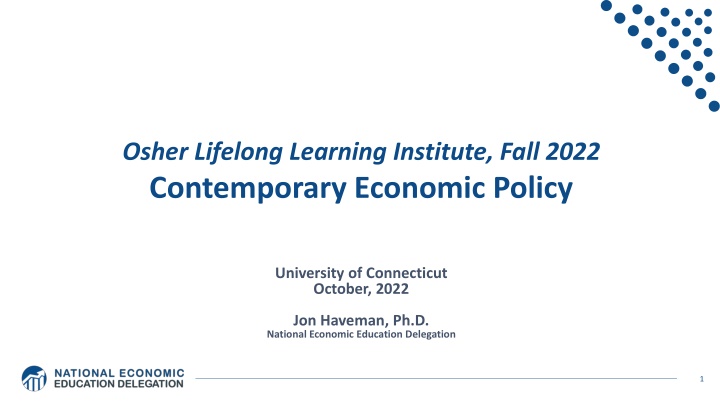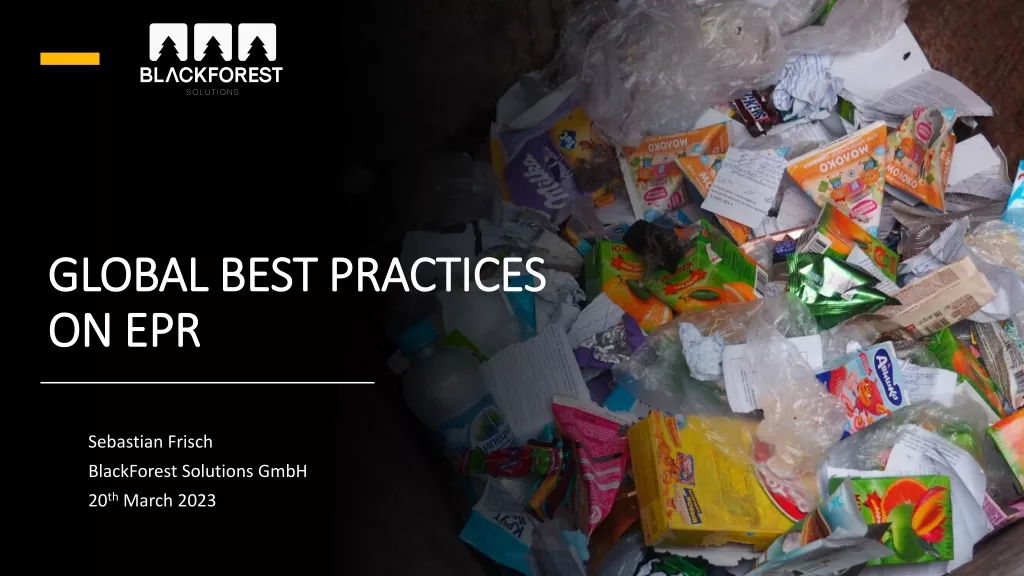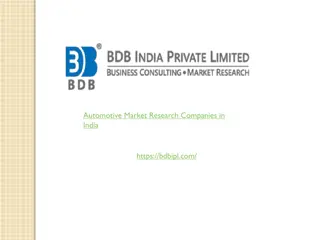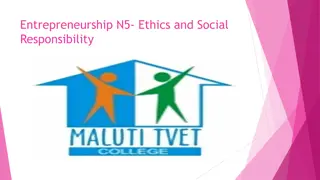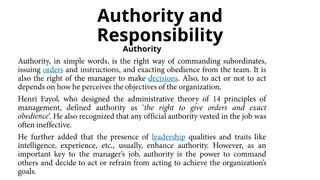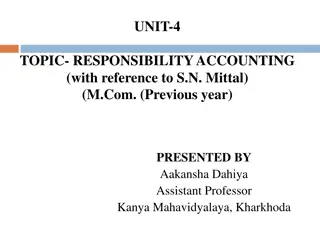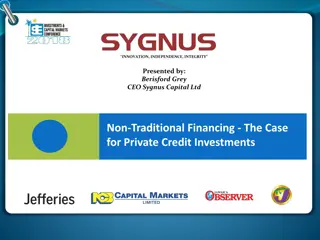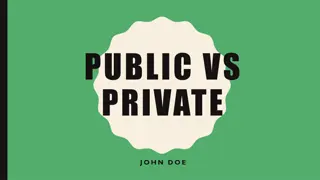Elements of Business Responsibility in Private Healthcare in India
This presentation discusses business responsibility in the context of private healthcare in India, covering topics such as the historical background, policies, delivery mechanisms, and the role of government. It also outlines the definition and conceptual clarity of Corporate Social Responsibility (CSR) in the Indian business landscape.
Download Presentation

Please find below an Image/Link to download the presentation.
The content on the website is provided AS IS for your information and personal use only. It may not be sold, licensed, or shared on other websites without obtaining consent from the author.If you encounter any issues during the download, it is possible that the publisher has removed the file from their server.
You are allowed to download the files provided on this website for personal or commercial use, subject to the condition that they are used lawfully. All files are the property of their respective owners.
The content on the website is provided AS IS for your information and personal use only. It may not be sold, licensed, or shared on other websites without obtaining consent from the author.
E N D
Presentation Transcript
Osher Lifelong Learning Institute, Fall 2022 Contemporary Economic Policy University of Connecticut October, 2022 Jon Haveman, Ph.D. National Economic Education Delegation 1
Available NEED Topics Include: US Economy Immigration Economics Healthcare Economics Housing Policy Climate Change Federal Budgets Economic Inequality Federal Debt Economic Mobility Black-White Wealth Gap Trade and Globalization Autonomous Vehicles Minimum Wages US Social Policy 2
Course Outline Contemporary Economic Policy - Week 1 (10/3): Economics of Immigration (Roger White, Whittier College) - Week 2 (10/10): US Economic Update (Jon Haveman, NEED) - Week 3 (10/17): Cryptocurrencies (Geof Woglom, Amherst College) - Week 4 (10/14): Trade and Globalization (Avik Chakrabarti, UW-Milwaukee) 3
Submitting Questions Please submit questions in the chat or raise your hand. - I will try to handle them as they come up, but may ask you to defer. We will do a verbal Q&A once the material has been presented. Slides will be available on NEED s website( www.NEEDelegation.org) 4
Cryptocurrencies & The Future of Money University of Connecticut October 17, 2022 Geoffrey Woglom Amherst College (emeritus) 5
Outline of the Talk Fun Facts about Bitcoin A little bit on the underlying technology of bitcoin. Economist evaluation of 2 Key Questions 1. Is Bitcoin serving a legitimate economic role? 2. Is there potential for beneficial, financial innovations using the underlying technology? But, in order to tap that potential, we need: 1. Legislation to provide good regulation of crypto markets. 2. The Federal Reserve needs to follow other central banks in creating a safe and secure, digital means of payment: Central Bank Digital Currency (CBDC) 6
But First, What is Bitcoin? Bitcoin is the first cryptocurrency and was invented in 2008. Cryptocurrencies are a form of digital money (viz. data on a computer) where account ownership is confidential and where record keeping is decentralized over a multitude of computers More importantly, 7
Bitcoin Has Started a Revolution in Finance 1. The way we buy and sell things, our payments system; the way we save, borrow and invest; the role of banks and other financial firms are rapidly changing. 2. In my view, Bitcoin will NOT be an important player in these developments, but the technologies underlying Bitcoin may be. 8
Bitcoins: What Is All the Excitement About? Was $19,550, 0n 10/17, 11:45 AM 9
An Origin Story Worthy of a Pulp Novel! The Mysterious Satoshi Nakamoto: - Lehman Brothers Bankruptcy, 9/2008 - Halloween 2008: a white paper is published on the Internet laying out the idea and design for Bitcoin. The author (or authors) used Satoshi Nakamoto as a pseudonym. - January 2009: Satoshi releases the first version of the Bitcoin software. - 2009-2010: Satoshi releases new versions of the software and is actively involved in Internet Chatter about Bitcoin. - April 2011: Satoshi ceases all known and/or verified communications. To this date the identity or identities of Satoshi are unknown. 12
The Possible Economic Role for Bitcoin Satoshi s Vision: A purely peer-to-peer version of electronic cash [that] would allow online payments to be sent directly from one party to another without going through a financial institution. More, prosaically 1. Facilitate payments at lower costs with speed and security 1. E.g., Credit Card Fees (3 percent). 2. Merchant doesn t get paid for at least 2 days. 3. More importantly, cross-border transactions costs were $1.9 trillion in 2018. 4. 2019 Capital One hackers access personal information of 106 m users 2. Meet the needs of previously unbanked. 1. Particularly a problem in the Developing World, but 2. Fed estimates that 50 million US adults have little or no banking relationships. 13
Facts about Cryptocurrencies (as of 10/17) Bitcoin was the first and is the largest in terms of market cap (total value of all bitcoins) of about $375 billion. Ethereum is in second place with a market cap of about $160 billion. Presently, 11,500 different varieties with a total market cap of about $976 billion (https://www.coingecko.com/en) Market cap of domestically listed US companies is about $40 trillion. 14
Underlying Technology of Bitcoin 1. Digital Token (exists only as data on a computer) whose ownership is cryptographically protected. 2. Distributed Ledger, Block Chain Technology. 3. Software protocol the provides a consensus mechanism on the validity of new transactions. Payments based on trust, without a trusted third party. (i.e, a bank or the Fed). 15
So, how does it work? Jack, the owner of a bitcoin is given a public number or key and a private encrypted key. Jack can trade his bitcoin with Jill by using Jill s public key and verifying the transaction with his private key. The new transaction is then posted on a a number of different computers and can be read by anyone. The clearing of the transaction is done with public database or distributed ledger called a blockchain through a process know as bitcoin mining. First, Bitcoin Miners gather about 3000 new transactions into a block. The next step is to provide a decentralized mechanism to add the new block to the block chain and reach a consensus that the transactions are valid 16
Proof of Work: Bitcoin Mining The miners competition involves generating long, random numbers ( hashing ) until one of the numbers fits a precise set of attributes. Presently, miners produce on the order of 200 million trillion random numbers per second. The winning miner then adds the new block to the previous block in the blockchain. The total process takes about 10 minutes The incentive for miners is that the winner of the competition gets compensated with new bitcoins and transaction fees. However, the miner will not get the reward unless other miners subsequently add new blocks to the first miner s block. In this way transactions are added to the chain via a consensus of miners. 17
Bitcoin Mine 18
Question #1: Is Bitcoin serving an economic role Bitcoin is not and cannot be widely used to make transactions Scalability? Price Instability. Transactions costs And, the network is costly 1. Resources used in mining 2. Environmental Costs BIS, Annual Report 2018, Chapter V 19
The Merge: Ethereum and Proof of Stake Potential Block Creators place cryptocurrency in specialized wallets that are locked while they are acting as blockchain validators (as opposed to miners ). Validators are selected randomly, where the odds of being selected are proportional to the value of the currency staked in the wallet. The rest of the process of validation is similar: transaction fees only paid if subsequent blocks are added, but!! If an invalid block is discovered the staked deposit is forfeited. 20
What Role Does Bitcoin (or Ether) Play? For some it plays the same role as $100 bills: 32.8% of all bills in circulation (more than the number of $1 bills) Illegal Activity 21
But What about as an Financial Investment? It is hard to argue with the fact that Bitcoin had provided outsized returns for many, albeit very volatile. Financial Assets are Promises by the Issuer The fundamental value of a financial assets is the value of those promises based on the time value of money and the risk that the promises will not be kept. What does Bitcoin promise? 23
How Do Economist Think About Investments? Good Starting Place In the short term the stock market behaves like a voting machine, but in the long term it acts like a weighing machine. What is being weighed is prospective payments from the security, or other intrinsic value, i.e. its fundamental value. Bitcoin? 24
Question #2: The Value of the New Technology? Don t Throw the baby out with the bathwater! The value cryptographically protected digital-tokens is nuanced: Blockchain technologies have significant promise some of which is already being realized. - Private blockchains, Walmart and its produce suppliers - Public Blockchains, Ethereum and smart contracts See: Mehta N,. Agashe A., P. Detroja Blockchain Bubble or Revolution, 2021 26
Smart Contracts on the Blockchain A Smart Contract is a computer code that resides on the block chain and is executed based on incoming information. Example, Parametric Hurricane Insurance via the Blockchain: - Computer program on Ethereum continuously monitors Charleston Executive Airport wind speed for 1 year. - If the windspeed is greater than 150 miles per hour, immediately transfers 100 bitcoin to the Seabrook Island Property Association. - If the windspeed is less than 150 miles per hour, but more than 125 miles per hour, immediately transfers 75 bitcoin; etc. Smart Contracts are Automatic, Immediate, Irreversible and Uncontestable. 27
DeFi and Smart Contracts Broad Category of Decentralized Financial Services - Crypto exchanges, online lending platforms, crypto derivatives, insurance, startup finance, etc. - Explosion over time: $1b in 2019; $15b in 2020; $100b as of 12/2021 (DefiPulse.com). [Recently, it has fallen] Smart Contracts are executed mostly on the Ethereum blockchain. No brokers, financial intermediaries, traders, and little regulation. I personally have not seen the killer application of DEFI Note in my insurance example, that bitcoin isn t a great means of payment because of price volatility. 28
Mark Zuckerberg & Stablecoins Enter Facebook and Diem in 2019: Proposed blockchain enabled stablecoin, where all Facebook users would have diem wallets. Regulators lodged lots of objections: Should a potentially ubiquitous private currency be run by one company? What could go wrong? Meta (Facebook) dropped out of the Diem project on 1/31/2022. 30
Tether Stablecoin: Reserve Backed? The Coin That Could Wreck Crypto (NYTIMES, 6/17): In 2021, New York s attorney general fined Tether $18.5 million and said the company had lied about its reserves, calling it a stablecoin without stability. Market cap of $68 billion; daily volume of $50 billion. What could go wrong? 31
Algorithmic Stablecoin Create a regular cryptocurrency and call it say, luna. If it has value: Create a stablecoin and call it say, terra, that is tied to luna. Smartcontract allows you to exchange terra into $1 worth or luna, or vice versa Luna = $10, terra = $1, trade 1 luna for 10 terra Luna = $1, terra =$1, trade 1 luna for 1 terra and vice versa Terra price drops to $0.80, buy terra and get $1 of luna - Increased demand for terra increases its price. Terra price rises to $1.20, sell terra and buy $1.20 of luna - Reduced demand for terra lowers its price. What could go wrong? 33
Lunas Price This Year https://coinmarketcap.com/ 34
Terras Price Death SpiRal!!! 35
It Is Still the Wild West! Web3 is Going Great! 36
Clean Up the Mess on Aisle 3 Gary Gensler, Chair of the SEC quote from a WP interview. Rostin Benham, Chair of the CFTC Janet Yellen at Treasury. They will act, but they would need Congressional legislation, too: Cash markets in cryptocurrencies are viewed as commodities and are unregulated 37
1930s Regulation in the 21st Century Bank: An institution that accepts deposits and makes loans for a profit. - Stablecoins? Investment Contract subject to security laws (Howey Test): 1. Investment of Money 2. Common Enterprise (pooling of funds) 3. Expectation of profit from effort others. - BlockFI and crypto Lending 38
Feb, 14, 2022, NYTimes Headline BlockFi, a crypto firm, reaches a $100 million settlement for failing to register loan products. 1. Cannot offer existing accounts to US residents. 2. BlockFi is working work with the SEC to develop an account that meets US security laws. 39
What is Good Regulation? The Principles Are Easy; 1. Eliminate fraud, abuse and manipulation. 2. Do not let markets be dominated by a small number of powerful firms. 3. Allow startups with new innovations to displace incumbent firms. 4. Minimize risk of a financial crisis. Legislation and Implementation: Not So Easy 40
Biden Framework for Regulating Crypto (9/16) 1. Protect Consumers, Investors, and Business. 2. Promote Access to Safe Financial Services. 3. Fostering Financial Stability. 4. Advancing Responsible Innovation. 5. Reinforcing our Global Financial Leadership. 6. Fighting Illicit Finance. 7. Exploring a U.S. Central Bank Digital Currency (CBDC) 41
Do We Need More Than (Good) Regulation? The Bank for International Settlement (BIS) and a number of central banks are exploring how the development of Central Bank Digital Currency (CBDC) contribute to an open, safe and competitive monetary environment that supports innovation and serves the public interest. Source of quotes, BIS Annual Report 2021 42
CBDCs and Other Central Bank Liabilities The Fed and most Central Banks presently already have digital money! CBDCs would permit wider access to the Fed s digital assets to other financial institutions and possibly to the public In addition, CBDCs could be designed for rapid settlement, finality, privacy and security (perhaps using blockchain technology) 43
The Devil Is In the Details Many countries as diverse as Sweden, Ecuador and China have begun experiments with CBDCs. Where s the Fed? Source: E. Prasad, The Future of Money 44
Trade: Avik Chakrabarti, UW-Milwaukee 46 Source: World Development Report 2020
Resources to Learn More N. Mehta, et.al. Blockchain Bubble or Revolution E Prasad, The Future of Money (https://youtu.be/o3NuHb7V1IA) Presidential Working Group on Financial Markets, 11/1/21 (https://home.treasury.gov/system/files/136/StableCoinReport_Nov1_5 08.pdf) Federal Reserve White paper (https://www.federalreserve.gov/publications/files/money-and- payments-20220120.pdf) Executive Order: https://www.whitehouse.gov/briefing- room/statements-releases/2022/03/09/fact-sheet-president-biden-to- sign-executive-order-on-ensuring-responsible-innovation-in-digital- assets/ 47
Glossary Traditional Money is currency plus bank checking accounts. Currency is paper and coin issued by the government. Currency is legal tender and must be accepted for all debts. Transactions using currency are immediate and final (can t be undone without the agreement of both parties.) Digital Payments are used for purchases where no physical money is exchanged. Examples include many online banking payments, credit card payments, PayPal. Digital Currency or Virtual currency is a form of money that exists solely in digital form, such as a digital token (i.e., as data on a computer). Examples: cryptocurrencies, central bank digital currencies and virtual currencies used in online gaming. Cryptographic identity protection assigns people two account numbers, or keys, one public and one private. Public record keeping is done using the public key and transactions are authorized using the private key. Cryptocurrency is a digital currency where the owner s identity is protected using cryptographic encryption and where record keeping is done with a public blockchain, e.g., Bitcoin. Stablecoin is a cryptocurrency with a stable value of $1, somewhat like a money market mutual fund. 48
Glossary (Cont.) Distributed ledger is a database for recording transactions or other information, where the information or ledger is shared on a network of many computers simultaneously. Blockchains are distributed ledgers where new transactions (new blocks) are added to the chain sequentially when a consensus of the network agrees that the transactions are valid. Proof of Work (POW) is a contest where miners use massive computing power to generate random numbers. The winning miner is the one who generates a number which meets precise characteristics. The more computing power (i.e., the more work ), the greater the chance of winning the competition. Bitcoin and most crypto currencies use POW. Proof of Stake (POS) is more of a lottery contest among validators (who play the same role as miners in POW). The validators get lottery tickets by tying up (or staking) crypto currencies on the blockchain network. The more currency staked, the greater the chance of winning the lottery. POS has not been used by many crypto currencies, but Ethereum switched to POS on September 14, and many people are holding their breath. 49
Glossary (Cont.) Decentralized Finance (DeFi) is peer-to-peer financial activity conducted through public blockchains and smart contracts. Smart Contracts are computer programs that execute automatically based on external conditions. Example, travel insurance that pays off automatically when a flight is cancelled. Central Bank Digital Currency (CBDC) is a digital currency issued by a central bank. Different central banks are experimenting with various forms of CBDCs, including some using blockchain technology, electronic wallets and cryptography. 50
